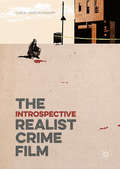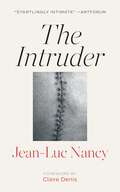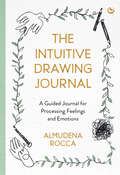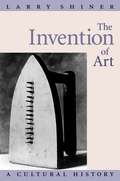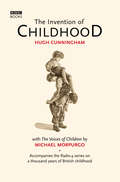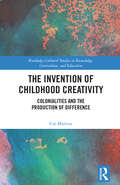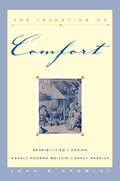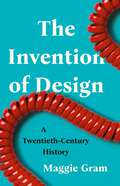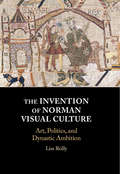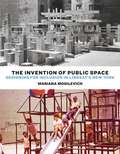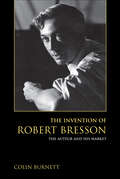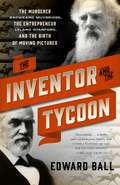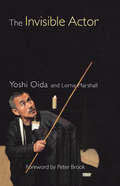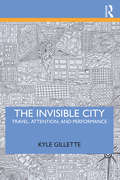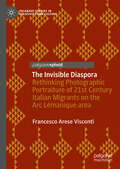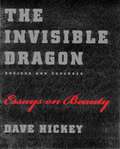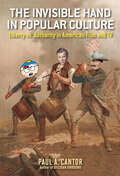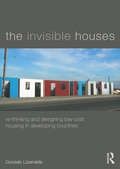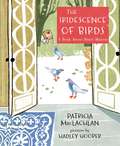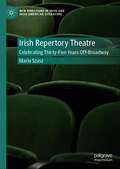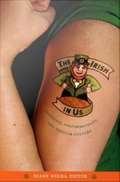- Table View
- List View
The Introspective Realist Crime Film
by Luis M. García-MainarThis book explores the formal and thematic conventions of crime film, the contexts in which these have flourished and their links with the social issues of a globalized world. The crime film has traditionally been identified with suspense, a heterogeneous aesthetic and a tacit social mind. However, a good number of the crime films produced since the early 2000s have shifted their focus from action or suspense and towards melodrama in narratives that highlight the social dimension of crime, intensify their realist aesthetics and dwell on subjectivity. With the 1940s wave of Hollywood semi-documentary crime films and 1970s generic revisionism as antecedents, these crime films find inspiration in Hollywood cinema and constitute a transnational trend. With a close look at Steven Soderbergh's Traffic (2000), David Fincher's Zodiac (2007), Jacques Audiard's Un prophète (2009) and Tomas Alfredson's Tinker Tailor Soldier Spy (2011), this book sets out the stylistic and thematic conventions, contexts and cultural significance of a new transnational trend in crime film.
The Introverted Actor: Practical Approaches
by Rob Roznowski Carolyn Conover Heidi KasevichDo you have to be an extrovert to succeed as an actor? This book offers ideas to create inclusive acting environments where the strengths of the introverted actor are as valued as those of their extroverted counterparts. As this book shows, many introverts are innately drawn to the field of acting, but can often feel inferior to their extroverted peers. From the classroom to professional auditions, from rehearsals to networking events, introverted actors tell their stories to help other actors better understand how to leverage their natural gifts, both onstage and off. In addition, The Introverted Actor helps to reimagine professional and pedagogical approaches for both actor educators and directors by offering actionable advice from seasoned psychology experts, professional actors, and award-winning educators.
The Intruder
by Jean-Luc NancyIn 1991, Jean-Luc Nancy's heart gave out. In one of the first such procedures in France, a stranger's heart was grafted into his body. Numerous complications followed, including more surgeries and lymphatic cancer. The procedure and illnesses he endured revealed to him, in a more visceral way than most of us ever experience, the strangeness of bodily existence itself and surviving the stranger within him. During this same period, Europe began closing its borders to those seeking refuge from war and poverty. Alarmed at this trend and drawn to a highly intimate form of strangeness with which he had been living for years, Nancy set out in The Intruder to articulate how intrusion—whether of a body or a border—is not antithetical to one’s identity but constitutive of it. In 2004, Claire Denis adapted The Intruder into a film already hailed among the most important of our century. This edition includes Nancy’s and Denis’s accounts of turning philosophy into film and the text of a shorter collaboration between the two of them. Throughout, Nancy and Denis push us to recognize that to truly welcome strangers means a constant struggle against exoticism, enforced assimilation, and confidence in our own self-identity.
The Intuitive Drawing Journal: A Guided Journal for Processing Feelings and Emotions
by Almudena RoccaProcess your emotions and improve your wellbeing with this inspiring guided journal which introduces intuitive drawing as an evolution of mindful drawing.What if drawing could help you express and process your emotions?Emotions add depth to our experiences, but sometimes they can be overwhelming or challenging. In this beautifully illustrated guided journal, Almudena Rocca presents an amazing technique – intuitive drawing – which will help you to understand and work through your feelings by accessing your unconscious.You will learn essential intuitive drawing skills, from working with patterns to drawing objects, before diving into 11 core emotions, including anger, fear and trust. This journal is filled with thought-provoking drawing prompts and quotes, allowing you to explore memories, relationships and events that may still impact you today.You don&’t need to be an artist to enjoy this book – it is the perfect resource for anyone who enjoys creative self-care.
The Invention of Art: A Cultural History
by Larry ShinerWith The Invention of Art, Larry Shiner challenges our conventional understandings of art and asks us to reconsider its history entirely, arguing that the category of fine art is a modern invention—that the lines drawn between art and craft resulted from key social transformations in Europe during the long eighteenth century.
The Invention of Childhood
by Hugh CunninghamThe Invention of Childhood will paint a vivid picture of the lives of children in Britain from pagan Anglo-Saxon times to the present day. Drawing heavily on primary sources, such as diaries, autobiographies, paintings, photographs and letters, the book will present a complete chronological history of the experience of children in Britain during the past 1500 years. We will learn the key elements that have shaped their lives down the ages and how this has differed as a result of gender, geography and ethnicity. The book will also relate children's lives to larger events in national and international history. Written by Hugh Cunningham the Professor of History at the Universtity of Kent at Canterbury, and an expert on childhood history - the book will accompany the Radio 4 series presented by the highly respected children's author Michael Morpurgo. Michael is contributing a lengthy foreword to the book. 'The Invention of Childhood' will expand on a number of key themes from the radio series, including the idea of childhood as a distinct stage of life. Opinions on when childhood should start and end, and how it differs from adulthood have changed considerably down the centuries. And these inventions and reinventions of childhood (hence the title) have had a profound effect on children's lives. The prolonged childhood we enjoy in Britain today was a luxury few could afford in the past. This fascinating study will draw attention to the ways in which we may find childhood and children in the past quite similar to the present and to ways in which childrens lives from the past seem to differ sharply from the lives children lead today.
The Invention of Childhood Creativity: Colonialities and the Production of Difference (Routledge Cultural Studies in Knowledge, Curriculum, and Education)
by Cat MartinsThis text offers a comprehensive analysis of the concept of the modern creative and imaginative child in Western education. Drawing on archived sources and historical works, it reframes childhood creativity as a social, cultural, and scientific construction, asking how our thinking and acting toward the creative child have been produced historically. The text dissects the discursive construction of creativity as a natural and developmental attribute of the child. It argues that the idea of the White creative child, constructed through comparative reasoning, shaped by primitivism, and illustrated through botanical metaphors as close to nature and the senses, is a notion embedded with colonialities, forming part of a Western civilizing project and entrenched power-knowledge relations. A compelling and original account of childhood creativity, this text will appeal to researchers in arts education, early childhood education, curriculum studies, and the history of education.
The Invention of Coinage and the Monetization of Ancient Greece
by David M. SchapsCoinage appeared at a moment when it fulfilled an essential need in Greek society and brought with it rationalization and social leveling in some respects, while simultaneously producing new illusions, paradoxes, and new elites. In a book that will encourage scholarly discussion for some time, David M. Schaps addresses a range of important coinage topics, among them money, exchange, and economic organization in the Near East and in Greece before the introduction of coinage; the invention of coinage and the reasons for its adoption; and the developing use of money to make more money. David M. Schaps is Professor of Classics at Bar-Ilan University in Israel.
The Invention of Comfort: Sensibilities and Design in Early Modern Britain and Early America
by John E. CrowleyHow did our modern ideas of physical well-being originate? As John Crowley demonstrates in The Invention of Comfort, changes in sensible technology owed a great deal to fashion-conscious elites discovering discomfort in surroundings they earlier had felt to be satisfactory.Written in an engaging style that will appeal to historians and material culture specialists as well as to general readers, this pathbreaking work brings together such disparate topics of analysis as climate, fire, food, clothing, the senses, and anxiety—especially about the night.
The Invention of Comfort: Sensibilities and Design in Early Modern Britain and Early America
by John E. CrowleyA history and analysis of the development of domestic design in early modern Britain and America.How did our modern ideas of physical well-being originate? As John Crowley demonstrates in The Invention of Comfort, changes in sensible technology owed a great deal to fashion-conscious elites discovering discomfort in surroundings they earlier had felt to be satisfactory.Written in an engaging style that will appeal to historians and material culture specialists as well as to general readers, this pathbreaking work brings together such disparate topics of analysis as climate, fire, food, clothing, the senses, and anxiety—especially about the night.“Riveting. . . . A solid contribution to the literature on the cultural impact of gentility, refinement, and the “baubles of Britain” in England and its colonial possessions.” —Journal of American History“Crowley provides a masterly search and survey that no historian of material culture should miss, and every curious reader should consider.” —Eugen Weber, Phi Beta Kappa Key Reporter“A comprehensive and tight study . . . a valuable contribution to the field, [and] one that is enjoyable to read.” —Emma Hart, English Historical Review“The sheer range of evidence, the interweaving of themes, and the overall strength of the argument mean [this] is an ideal book for specialists and students alike.” —Helen Clifford, Journal of Design History“The Invention of Comfort is an important and thought-provoking book that challenges our understanding of why people live that way they do.” —Marie Morgan, New England Quarterly
The Invention of Design: A Twentieth-Century History
by Maggie GramFrom a brilliant cultural historian, &“a secret history of the twentieth century&” (Louis Menand) told through the story of design and its utopian promises Design has penetrated every dimension of contemporary society, from classrooms to statehouses to corporate boardrooms. It&’s seen as a kind of mega-power, one that can solve all our problems and elevate our experiences to make a more beautiful, more functional world. But there&’s a backstory here. In The Invention of Design, designer and historian Maggie Gram investigates how, over the twentieth century, our economic hopes, fears, and fantasies shaped the idea of &“design&”—then repeatedly redefined it. Nearly a century ago, resistance to New Deal–era government intervention helped transform design from an idea about aesthetics into one about function. And at century&’s end, the dot-com crash brought us &“design thinking&”: the idea that design methodology can solve any problem, small or large. To this day, design captures imaginations as a tool for fixing market society&’s broken parts from within, supposedly enabling us to thrive within capitalism&’s sometimes violent constraints. A captivating critical history, The Invention of Design shows how design became the hero of many of our most hopeful stories—dreams, fantasies, utopias—about how we might better live in a modern world.
The Invention of Norman Visual Culture: Art, Politics, and Dynastic Ambition
by Lisa ReillyIn this book, Lisa Reilly establishes a new interpretive paradigm for the eleventh and twelfth-century art and architecture of the Norman world in France, England, and Sicily. Traditionally, scholars have considered iconic works like the Cappella Palatina and the Bayeux Embroidery in a geographically piecemeal fashion that prevents us from seeing their full significance. Here, Reilly examines these works individually and within the larger context of a connected Norman world. Just as Rollo founded the Normandy 'of different nationalities', the Normans created a visual culture that relied on an assemblage of forms. To the modern eye, these works are perceived as culturally diverse. As Reilly demonstrates, the multiple sources for Norman visual culture served to expand their meaning. Norman artworks represented the cultural mix of each locale, and the triumph of Norman rule, not just as a military victory but as a legitimate succession, and often as the return of true Christian rule.
The Invention of Public Space: Designing for Inclusion in Lindsay's New York
by Mariana MogilevichThe interplay of psychology, design, and politics in experiments with urban open space As suburbanization, racial conflict, and the consequences of urban renewal threatened New York City with &“urban crisis,&” the administration of Mayor John V. Lindsay (1966–1973) experimented with a broad array of projects in open spaces to affirm the value of city life. Mariana Mogilevich provides a fascinating history of a watershed moment when designers, government administrators, and residents sought to remake the city in the image of a diverse, free, and democratic society.New pedestrian malls, residential plazas, playgrounds in vacant lots, and parks on postindustrial waterfronts promised everyday spaces for play, social interaction, and participation in the life of the city. Whereas designers had long created urban spaces for a broad amorphous public, Mogilevich demonstrates how political pressures and the influence of the psychological sciences led them to a new conception of public space that included diverse publics and encouraged individual flourishing. Drawing on extensive archival research, site work, interviews, and the analysis of film and photographs, The Invention of Public Space considers familiar figures, such as William H. Whyte and Jane Jacobs, in a new light and foregrounds the important work of landscape architects Paul Friedberg and Lawrence Halprin and the architects of New York City&’s Urban Design Group.The Invention of Public Space brings together psychology, politics, and design to uncover a critical moment of transformation in our understanding of city life and reveals the emergence of a concept of public space that remains today a powerful, if unrealized, aspiration.
The Invention of Robert Bresson: The Auteur and His Market
by Colin BurnettChallenging the prevailing notion among cinephiles that the auteur is an isolated genius interested primarily in individualism, Colin Burnett positions Robert Bresson as one whose life's work confronts the cultural forces that helped shape it. Regarded as one of film history's most elusive figures, Bresson (1901–1999) carried himself as an auteur long before cultural magazines, like the famed Cahiers du cinéma, advanced the term to describe such directors as Jacques Tati, Alfred Hitchcock, and Jean-Luc Godard. In this groundbreaking study, Burnett combines biography with cultural history to uncover the roots of the auteur in the alternative cultural marketplace of midcentury France.
The Inventor and the Tycoon: A Gilded Age Murder and the Birth of Moving Pictures
by Edward BallFrom the National Book Award-winning author of Slaves in the Family, a riveting true life/true crime narrative of the partnership between the murderer who invented the movies and the robber baron who built the railroads. One hundred and thirty years ago Eadweard Muybridge invented stop-motion photography, anticipating and making possible motion pictures. He was the first to capture time and play it back for an audience, giving birth to visual media and screen entertainments of all kinds. Yet the artist and inventor Muybridge was also a murderer who killed coolly and meticulously, and his trial is one of the early instances of a media sensation. His patron was railroad tycoon (and former California governor) Leland Stanford, whose particular obsession was whether four hooves of a running horse ever left the ground at once. Stanford hired Muybridge and his camera to answer that question. And between them, the murderer and the railroad mogul launched the age of visual media. Set in California during its frontier decades, The Tycoon and the Inventor interweaves Muybridge's quest to unlock the secrets of motion through photography, an obsessive murder plot, and the peculiar partnership of an eccentric inventor and a driven entrepreneur. A tale from the great American West, this popular history unspools a story of passion, wealth, and sinister ingenuity.
The Invisible Actor
by Lorna Marshall Yoshi OidaFirst Published in 1998. Routledge is an imprint of Taylor & Francis, an informa company.
The Invisible Body in Chinese Calligraphy and Painting (China Academic Library)
by Jianping GaoThis book explores Chinese calligraphy and painting from an aesthetic perspective, using modern visual theory to analyze the theoretical implications of the relationship between ancient Chinese literati painting and calligraphy, in contrast to Western aesthetic traditions. It highlights the action-oriented nature of Chinese calligraphy and painting, demonstrating that these art forms should be viewed not as static images, but as dynamic traces of the artist’s expressive movements. This book is ideal for those interested in aesthetics, art historians, scholars of visual theory, and anyone fascinated by the dynamic essence of Chinese artistic traditions.
The Invisible City: Travel, Attention, and Performance
by Kyle GilletteThe Invisible City explores urban spaces from the perspective of a traveller, writer, and creator of theatre to illuminate how cities offer travellers and residents theatrical visions while also remaining mostly invisible, beyond the limits of attention. The book explores the city as both stage and content in three parts. Firstly, it follows in pattern Italo Calvino's novel Invisible Cities, wherein Marco Polo describes cities to the Mongol emperor Kublai Khan, to produce a constellation of vignettes recalling individual cities through travel writing and engagement with artworks. Secondly, Gillette traces the Teatro Potlach group and its ongoing immersive, site-specific performance project Invisible Cities, which has staged performances in dozens of cities across Europe and the Americas. The final part of the book offers useful exercises for artists and travellers interested in researching their own invisible cities. Written for practitioners, travellers, students, and thinkers interested in the city as site and source of performance, The Invisible City mixes travelogue with criticism and cleverly combines philosophical meditations with theatrical pedagogy.
The Invisible Diaspora: Rethinking Photographic Portraiture of 21st Century Italian Migrants on the Arc Lémanique area (Palgrave Studies in Creativity and Culture)
by Francesco Arese ViscontiThis book reviews photographic portrayals of contemporary Italian migrants living in the area between Lausanne and Geneva in Switzerland (Arc Lémanique). Drawing from the archives of Swiss-French illustrated magazines (L’Illustré and L’Hebdo) and other online publications, the author analyses the distinctive photographic representations of Italian migrants in Switzerland from the 1960s to 2019 and uses them to produce new photographic portraits of the 21st century Italian migrants on the Arc Lémanique. Challenging the narrative on the brain drain, the book showcases 24 portraits of Italians living in Switzerland with the aim to unveil the unique and complex nature of a new Italian diaspora in the age of globalization. The combination of theories, concepts, and methodologies used reflects the interdisciplinary and creative approach of this research, which brings together culture, identity, photography, and creative process. Based on the lived experience of the author as an Italian migrant in Switzerland, the book offers a profound analysis of the phenomenon of migration and identity through visual communication. The interviews included in chapter 4 were originally conducted and recorded by the author in Italian. The English version is the result of a translation done with the help of artificial intelligence. The author has subsequently corrected and revised the text further in an endeavour to refine the work stylistically.
The Invisible Dragon: Essays on Beauty
by Dave HickeyThe Invisible Dragon made a lot of noise for a little book When it was originally published in 1993 it was championed by artists for its forceful call for a reconsideration of beauty--and savaged by more theoretically oriented critics who dismissed the very concept of beauty as naive, igniting a debate that has shown no sign of flagging. With this revised and expanded edition, Hickey is back to fan the flames. More manifesto than polite discussion, more call to action than criticism, The Invisible Dragon aims squarely at the hyper-institutionalism that, in Hickey's view, denies the real pleasures that draw us to art in the first place. Deploying the artworks of Warhol, Raphael, Caravaggio, and Mapplethorpe and the writings of Ruskin, Shakespeare, Deleuze, and Foucault, Hickey takes on museum culture, arid academicism, sclerotic politics, and more--all in the service of making readers rethink the nature of art. A new introduction provides a context for earlier essays--what Hickey calls his "intellectual temper tantrums. " A new essay, "American Beauty," concludes the volume with a historical argument that is a rousing paean to the inherently democratic nature of attention to beauty. Written with a verve that is all too rare in serious criticism, this expanded and refurbished edition of The Invisible Dragon will be sure to captivate a new generation of readers, provoking the passionate reactions that are the hallmark of great criticism.
The Invisible Hand in Popular Culture: Liberty vs. Authority in American Film and TV
by Paul A. Cantor“Analyzes how ideas about economics and political philosophy find their way into everything from Star Trek to Malcolm in the Middle.” —Wall Street JournalPopular culture often champions freedom as the fundamentally American way of life and celebrates the virtues of independence and self-reliance. But film and television have also explored the tension between freedom and other core values, such as order and political stability. What may look like healthy, productive, and creative freedom from one point of view may look like chaos, anarchy, and a source of destructive conflict from another. Film and television continually pose the question: Can Americans deal with their problems on their own, or must they rely on political elites to manage their lives?In this groundbreaking work, Paul A. Cantor—whose previous book, Gilligan Unbound, was named one of the best nonfiction books of the year by the Los Angeles Times—explores the ways in which television shows such as Star Trek, The X-Files, South Park, and Deadwood and films such as The Aviator and Mars Attacks! have portrayed both top-down and bottom-up models of order. Drawing on the works of John Locke, Adam Smith, Alexis de Tocqueville, and other proponents of freedom, Cantor contrasts the classical liberal vision of America?particularly its emphasis on the virtues of spontaneous order?with the Marxist understanding of the “culture industry” and the Hobbesian model of absolute state control.The Invisible Hand in Popular Culture concludes with a discussion of the impact of 9/11 on film and television, and the new anxieties emerging in contemporary alien-invasion narratives: the fear of a global technocracy that seeks to destroy the nuclear family, religious faith, local government, and other traditional bulwarks against the absolute state.
The Invisible Houses: Rethinking and designing low-cost housing in developing countries
by Gonzalo LizarraldeWinner of the ACSA/AIA Housing Design Education Award! There is an increased interest among architects, urban specialists and design professionals to contribute to solve "the housing problem" in developing countries. The Invisible Houses takes us on a journey through the slums and informal settlements of South Africa, India, Colombia, Honduras, El Salvador, Cuba, Haiti and many other countries of the Global South, revealing the challenges of, and opportunities for, improving the fate of millions of poor families. Stressing the limitations of current approaches to housing development, Gonzalo Lizarralde examines the short-, mid- and long-term consequences of housing intervention. The book covers – among others – the issues of planning, design, infrastructure and project management. It explains the different variables that need to be addressed and the causes of common failures and mistakes, while outlining successful strategies based on embracing a sustained engagement with the complexity of processes that are generally invisible.
The Iridescence of Birds: A Book About Henri Matisse
by Patricia MacLachlanIf you were a boy named Henri Matisse who lived in a dreary town in northern France, what would your life be like? Would it be full of color and art? Full of lines and dancing figures? Find out in this beautiful, unusual picture book about one of the world's most famous and influential artists by acclaimed author and Newbery Medal-winning Patricia MacLachlan and innovative illustrator Hadley Hooper.
The Irish Repertory Theatre: Celebrating Thirty-Five Years Off-Broadway (New Directions in Irish and Irish American Literature)
by Maria SzaszThe Irish Repertory Theatre: Celebrating Thirty-Five Years Off-Broadway is the first book-length history of the multi-award winning Off-Broadway Irish Repertory Theatre Company, from its beginning in 1988 to its thirty-fifth season in 2023. The book considers how the Irish Rep’s plays and musicals reflect the Irish diaspora, the relationship between Ireland and America, and what it means to be Irish and Irish American, both historically, and in the twenty-first century, including how the Irish Rep is showcasing more diverse voices and experiences, from women, the LGBTQIA+ community, and Irish and Irish American people of color.
The Irish in Us: Irishness, Performativity, and Popular Culture
by Diane NegraOver the past decade or so, Irishness has emerged as an idealized ethnicity, one with which large numbers of people around the world, and particularly in the United States, choose to identify. Seeking to explain the widespread appeal of all things Irish, the contributors to this collection show that for Americans, Irishness is rapidly becoming the white ethnicity of choice, a means of claiming an ethnic identity while maintaining the benefits of whiteness. At the same time, the essayists challenge essentialized representations of Irishness, bringing attention to the complexities of Irish history and culture that are glossed over in Irish-themed weddings and shamrock tattoos. Examining how Irishness is performed and commodified in the contemporary transnational environment, the contributors explore topics including Van Morrison's music, Frank McCourt's writing, the explosion of Irish-themed merchandising, the practices of heritage seekers, the movie The Crying Game, and the significance of red hair. Whether considering the implications of Garth Brooks's claim of Irishness and his enormous popularity in Ireland, representations of Irish masculinity in the TV series Buffy the Vampire Slayer and Angel, or Americans' recourse to a consoling Irishness amid the racial and nationalist tensions triggered by the events of September 11, the contributors delve into complex questions of ethnicity, consumerism, and globalization. Ultimately, they call for an increased awareness of the exclusionary effects of claims of Irishness and for the cultivation of flexible, inclusive ways of affiliating with Ireland and the Irish. Contributors. Natasha Casey, Maeve Connolly, Catherine M. Eagan, Sean Griffin, Michael Malouf, Mary McGlynn, Gerardine Meaney, Diane Negra, Lauren Onkey, Maria Pramaggiore, Stephanie Rains, Amanda Third
